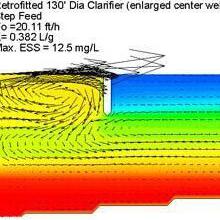Implementation of Aeration Control and Internal Mixed Liquor Recycle Control in IFAS Facility
Last Modified Feb 01, 2022
Introduction
The implementation of advanced aeration control strategies at wastewater treatment plants (WWTPs) to improve biological processes for nitrogen and phosphorus removal are rapidly developing. Additionally, since blowers are the largest single user of energy at WWTPs, and overall aeration operation contributes up to 75% of energy costs, the desire to optimize these strategies are becoming more prevalent (Amand et al., 2013; Rosso et al., 2008). Aeration control strategies utilize specific parameter measuring devices such as ammonia, nitrate, nitrite, phosphorus, dissolved oxygen in conjunction with control concepts to provide a cost-saving alternative to increasing reactor volume (Rieger, 2004; Vanrolleghem et al., 2003).
Facility Design
The Hampton Roads Sanitation District’s (HRSD) James River Wastewater Treatment Plant (JRWWTP), located in Newport News, Virginia, is hydraulically rated for 20 MGD (75,700 m3 day-1). Domestic waste, with approximately 10% industrial waste, travels by means of a gravity/force main collection system leading to mild septicity and a medium strength wastewater.
JRWWTP operates a 4-stage Bardenpho configuration with integrated fixed-film activated sludge (IFAS) in the aerobic zone, utilizing an approximate 45% fill of AnoxKaldnes K3 plastic media with a specific surface area of 500 m2 m-3. In order to achieve denitrification while preventing media migration, two internal mixed liquor recycles (IMLR) discharge to the initial cell of the first anoxic zone. Supplemental carbon addition to the second anoxic zone does not occur, thus, its primary function is to serve as a deoxygenation zone, rather than for denitrification.
JRWWTP has 3 multi-stage centrifugal and 3 direct drive high speed turbo blowers that feed into a common header. A pressure control loop is used to manipulate the turbo blowers to maintain a header pressure setpoint, while the centrifugal blowers are typically operated at constant maximum airflow. Each aeration basin has six drop legs, with the first and last utilizing manual valves to adjust airflow and the rest being automatic, utilizing motor operated valves.
Aeration basin profile data indicated ammonia oxidation was complete within the first two thirds of the basin, causing excessive oxygen bleeding into the anoxic zone via the two IMLRs, leading to a wastage of influent carbon. Therefore, the control logic was developed in order to: 1) Minimize DO transfer through the IMLRs 2) Optimize overall TIN removal through better utilization of influent carbon 3) Reduce aeration demands and achieve stable blower operation.
Ammonia Based Aeration Control Operations
At JRWWTP, during conventional DO control mode (CDOC), a DO setpoint controls the second and third drop leg, while another DO setpoint controls the fourth and fifth drop leg. Ammonia based aeration control (ABAC) was implemented by adding a second cascading control loop utilizing a feedback PID controller to the existing CDOC. An ion selective electrode (ISE) ammonia probe located at the aeration effluent continuously relays the ammonia concertation to the ammonia PID controller. The ammonia PID controller calculates a DO setpoint based on the difference between the ammonia probe feedback and the desired ammonia setpoint. The calculated DO setpoint is transferred to the CDOC controller, which would modulate the values to meet the DO setpoint. DO is measured continuously in each zone. ABAC technology in IFAS systems is patented in the United States under number US: 8,268,173 B2.
Ammonia versus Nitrate Control Operations
Ammonia versus nitrate (AvN) control was implemented by adding a second cascading control loop and a feedback PID controller to the existing CDOC logic (Figure 4). An ammonia ISE probe and Nitrate UV sensor located in the aeration effluent channel continuously relays the ammonia and nitrate concertation to the AvN PID controller, which calculates a DO setpoint based on the difference between the calculated AvN ratio feedback and the desired AvN ratio setpoint. The desired AvN ratio can be chosen utilizing three different methods: 1) a static AvN ratio 2) a dynamic ratio that would change based upon predetermined time steps 3) a dynamic ratio which would change based upon influent loading.
Additional Valve Control for Blower Control and Media Mixing
While low DO operation is desirable, there was the potential concern of media accumulation due to minimal mixing. In order to alleviate the issue, a surge aeration mixing control was developed. If the valve position was at the minimal for an extended period, then all the valves would open to 30 % briefly, to ensure the media was incorporated into the liquid stream.
In addition, the mix of blower technologies entering a common header along with low DO setpoints gave rise to the concern for blower surges. An air release program was established, so that if the pressure header exceeded a set point, then the valves in one tank would increase their position and serve as a blow off tank. In order to minimize disruption to the aeration controllers, the tank with the highest calculated DO setpoint would be chosen as the blow off tank which would allow for maximum use of the aeration.
Nitrate Based Internal Mixed Liquor Recycle Control Operations
The conventional IMLR (IMLR) control utilized a percent based of plant influent flow technique. Since there are two IMLRs, the IMLR 2 located in the second anoxic zone served as the main controller, wherein the signal from the plant influent flow meter (smoothed to 30 minute averages) was used to calculate the needed pump speed. The IMLR 1 was controlled as an operator input ratio of the IMLR 2.
Nitrate based IMLR Control (NIMLR) was implemented by adding a second loop and a PID controller to the IMLR. A nitrate sensor located at the end of first anoxic zone continuously sent the nitrate concertation to the PID controller where it was compared to the nitrate setpoint. The output of the PID controller was scaled to become a percent of plant influent flow. The percent setpoint was then sent to the IMLR control which would ramp the pump up or down to meet the nitrate setpoint.
During high flow events, the IMLR would resume operation and enter weather mode where the IMLR 2 pump would shut off and the IMLR 1 pump would ramp up to 100% of pump capacity to mitigate the potential for media building up on the downstream sieves.
Project Status
All the described controls have been fully implemented with ongoing data collection. Results suggest low DO operations utilizing both AvN and ABAC are possible in an IFAS system. Furthermore, nitrate based IMLR control indicates increased TIN removal is achievable through improved carbon usage.
An inCTRL SIMBA# water model (version 2.0) has been developed for the JRWWTP with the aeration and ILMR controls. It will be utilized to 1) Evaluate optimal blower operation 2) The ratio of IMLR 1 to IMLR 2 for improved nitrate removal and carbon utilization 3) ABAC and AvN setpoints during seasonal changes.










